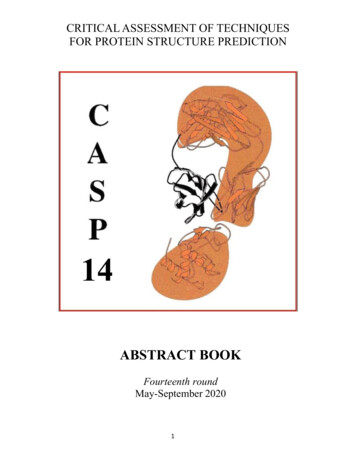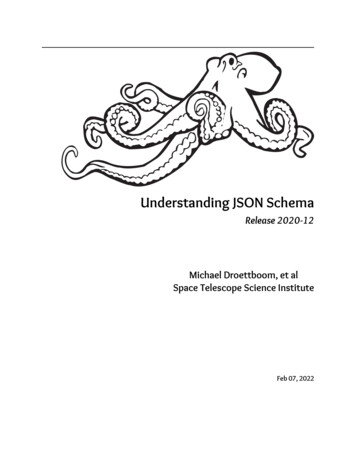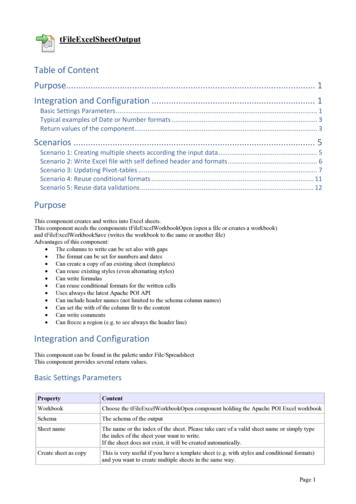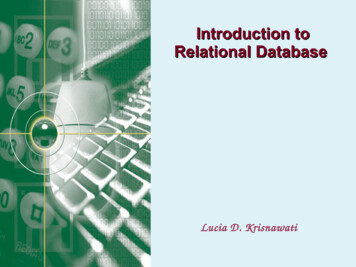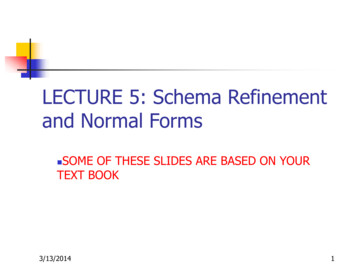
Transcription
LECTURE 5: Schema Refinementand Normal FormsSOME OF THESE SLIDES ARE BASED ON YOURTEXT BOOK 3/13/20141
titleyearlengthfilmTypestudioNamestarNameStar Wars1977124colorFoxCarrie FisherStar Wars1977124colorFoxMark HaillStar Wars1977124colorFoxHarrison FordMighty Ducks1991104colorDisneyEmilo EstevezWayne’s World199295colorParamountDana CarveyWayne’s World199295colorParamountMike Meyers Anomalies Insertion anomalies Deletion anomalies Cannot record filmType without starNameIf we delete the last star, we also lose the movie info.Modification (update) anomalies
NameStar Wars1977124colorFoxCarrie FisherStar Wars1977124colorFoxMark HaillStar Wars1977124colorFoxHarrison FordMighty Ducks1991104colorDisneyEmilo EstevezWayne’s World199295colorParamountDana CarveyWayne’s World199295colorParamountMike MeyerstitleyearstarNameStar Wars1977Carrie FisherStar Wars1977Mark HaillStar Wars1977Harrison FordMighty Ducks1991Emilo EstevezWayne’s World1992Dana CarveyWayne’s World1992Mike MeyerstitleyearlengthfilmTypestudioNameStar Wars1977124colorFoxMighty Ducks1991104colorDisneyWayne’s World199295colorParamount
Is there a possibility of an update, deletion, andinsertiona anomalies in the table below? Explain withexamplesStudentNumCourseNumStudent Name AddressCourseS219201JonesEdinburghAccounts ysicsS309201RichardsManchesterAccounts 1S309322RichardsManchesterMaths3/13/20144
Set valued attributes: example Consider a database of customer transactions You have customers represented by cid, and transactionsrepresented by tid, where each transaction has multipleitems, represented by itemid, together with name, quantityand the cost of the itemDesign a database to keep track of the transactionsof customers (set valued, vs flat design)Example queries: 3/13/2014what is the total sales in dollars per itemWhat is the total sales per customer5
Schema Refinement functional dependencies, can be used to identifyschemas with problems and to suggest refinements.Decomposition is used for schema refinement.3/13/20146
Example FD Database of beer drinkersNAMEADDRBEERLIKEDMANUFFAVBEERJohn DoeNY, SohoBud LightBWLeffeJohn DoeNY, SohoLeffeLFLeffeElisa DayDC, DupontGusto WeissGustoChimay BlueElisa DayDC, DupontChimay BlueChimayChimay Blue
Example FD titletitletitletitleyearyearyearyear lengthfilmTypestudioNamelength filmType eStar Wars1977124colorFoxCarrie FisherStar Wars1977124colorFoxMark HamillStar Wars1977124colorFoxHarrison FordMighty Ducks1991104colorDisneyEmilio EstevezWayne’s World199295colorParamountDana CarveyWayne’s World199295colorParamountMike Meyers
Functional Dependencies (FDs) A functional dependency X Y holds over relation R if, forevery allowable instance r of R: t1 r, t2 r, (t1) (t2) implies (t1) Y(t2)XYX t1t2i.e., given two tuples in r, if the X values agree, then the Y values mustalso agree. (X and Y are sets of attributes.)X1212YababZpqrp
Functional Dependencies (FDs)Does the following relation instance satisfy X- Y ?X1212YabacZpqrp
Functional Dependencies (FDs) A functional dependency X Y holds over relation R if, forevery allowable instance r of R: t1 r, t2 r, (t1) (t2) implies (t1) Y(t2)XYX An FD is a statement about all allowable relations. i.e., given two tuples in r, if the X values agree, then the Y values mustalso agree. (X and Y are sets of attributes.)Must be identified based on semantics of application.Given some allowable instance r1 of R, we can check if it violates someFD f, but we cannot tell if f holds over R!K is a candidate key for R means that K R However, K R does not require K to be minimal!
Functional Dependencies (FDs)Does the following relation instance satisfy X- Y ?X12133/13/2014YababZpqrp12
Functional Dependencies (FDs)If X is a candidate key, then X - Y Z !X12133/13/2014YababZpqrp13
Functional Dependencies (FDs)If Y Z - X can we say YZ is a candidate key?X12133/13/2014YababZpqrp14
Example: Constraints on Entity Set Consider relation obtained from Hourly Emps: Hourly Emps (ssn, name, lot, rating, hrly wages, hrs worked)Notation: We will denote this relation schema by listing the attributes:SNLRWH This is really the set of attributes {S,N,L,R,W,H}.Sometimes, we will refer to all attributes of a relation by using the relationname. (e.g., Hourly Emps for SNLRWH)Hourly EmpsSNLRWH
Example: Constraints on Entity Set Some FDs on Hourly Emps: ssn is the key: S SNLRWHrating determines hrly wages: R WDid you notice anything wrong with the following instance ?SNLRW1100220032502300H
Example: Constraints on Entity Set Some FDs on Hourly Emps: ssn is the key: S SNLRWHrating determines hrly wages: R WSalary should be the same for a given rating!SNLRW1100220032502200H
SExample Problems due to R NLR W H123-22-3666 Attishoo48 810 40231-31-5368 Smiley22 810 30131-24-3650 Smethurst 35 5730434-26-3751 Guldu35 5732612-67-4134 Madayan35 810 40 W:Update anomaly: Can we change W in just the 1st tuple ofSNLRWH? Insertion anomaly: What if we want to insert an employee and don’tknow the hourly wage for his rating?Deletion anomaly: If we delete all employees with rating 5, we losethe information about the wage for rating 5!
Hourly du355732612-67-4134Madayan3581040Hourly Emps2SNLR H123-22-3666 Attishoo48 840231-31-5368 Smiley22 830131-24-3650 Smethurst 35 530434-26-3751 Guldu35 532612-67-4134 Madayan35 840WagesRW81057
Refining an ER Diagram 1st diagram translated: Workers(S,N,L,D,S) Departments(D,M,B) Lots associated with workers.Suppose all workers in a dept are assigned the same lot: DsincenamessnEmployeesdnamelotdidWorks InbudgetDepartments L
Refining an ER Diagram Suppose all workers in a dept are assigned the same lot: DRedundancy; fixed by: Workers2(S,N,D,S) Dept Lots(D,L) Can fine-tune this: Workers2(S,N,D,S) Departments(D,M,B,L) budgetsincenamednamessnEmployeesdidWorks InlotDepartments L
Reasoning About FDs Given some FDs, we can usually infer additional FDs: did lotimpliesssn lotF closure of F is the set of all FDs that are implied by F.Armstrong’s Axioms (X, Y, Z are sets of attributes): did,An FD f is implied by a set of FDs F if f holds whenever all FDs in F hold. ssnReflexivity: If X Y, then YX (a trivial FD)Augmentation: If XY, then XZYZ for any ZTransitivity: If XY and YZ, then XZ These are sound and complete inference rules for FDs!
Reasoning About FDsSNLRWHFor example, in the above schemaS N - S is a trivial FDsince {S,N} is a superset of {S}
Reasoning About FDsSNLRWHFor example, in the above schemaIf S N - R W, then S N L - R W L (by augmentation)
Reasoning About FDs (Contd.) Couple of additional rules (that follow from AA): Union: If X - Y and X - Z, then X - YZProof: From X - Y, we have XX - XY (by augmentation)Note that XX is X, therefore X - XYFrom X - Z, we have XY - YZ (by augmentation)From X - XY and XY - YZ, we have X - YZ (by transitiviy)
Reasoning About FDs (Contd.) Couple of additional rules (that follow from AA): Decomposition: If X - YZ, then X - Y and X - Z Try to prove it at home/dorm/IC/Vitamin/DD/Bus!
Reasoning About FDs (Contd.) Example: Contracts(cid,sid,jid,did,pid,qty,value), and:C is the key: C CSJDPQVProject purchases each part using single contract: JPDept purchases at most one part from a supplier: SD C PJP C, C CSJDPQV imply JP CSJDPQVSD P implies SDJ JPSDJ JP, JP CSJDPQV imply SDJ CSJDPQV
Reasoning About FDs (Contd.) Computing the closure of a set of FDs ( F ) can be expensive.(Size of closure is exponential in # attrs!)Example: A database with 3 attributes (A,B,C) F {A- B, B- C} Find the closure of F denoted by F
Example Suppose we are given a relation scheme R (A,B,C,G,H,I), andthe set of functional dependencies, F provided below:A BA CCG HCG IB H Is A H logically implied by F? Is AG I logically implied by F?3/13/201429
Reasoning About FDs (Contd.) Computing the closure of a set of FDs ( F ) can be expensive.(Size of closure is exponential in # attrs!)Typically, we just want to check if a given FD X Y is in theclosure of a set of FDs F. An efficient check: Compute attribute closure of X (denoted X ) wrt F: Set of all attributes A such that X A is in FThere is a linear time algorithm to compute this.For each FD Y - Z in F, if X is a superset of Y then add Y toX
Reasoning About FDs (Contd.) Does F {A B, B C, C D E } imply A E? i.e, is A E in the closure F ? Equivalently, is E in A ? Letscompute A InitializeA to {A} :A {A} From A - B, we can add B to A : A {A, B} From B - C, we can add C to A : A {A, B, C} We can not add any more attributes, and A does not contain Etherefore A - E does not hold.
DB Design Guidelines 3/13/2014Design a relation schema with a clearly definedsemanticsDesign the relation schemas so that there is notinsertion, deletion, or modification anomalies. Ifthere may be anomalies, state them clearlyAvoid attributes which may frequently have nullvalues as much as possible.Make sure that relations can be combined by keyforeign key links32
Normal Forms Normal forms are standards for a good DB schema (introducedby Codd in 1972)If a relation is in a certain normal form (such as BCNF, 3NFetc.), it is known that certain kinds of problems areavoided/minimized.Normal forms help us decide if decomposing a relation helps.
Normal Forms First Normal Form: No set valued attributes (only atomic li 3ayse 4fatma
Normal Forms (Contd.) Role of FDs in detecting redundancy: Consider a relation R with 3 attributes, ABC. No FDs hold: There is no redundancy here.Given A - B: Several tuples could have the same A value, and if so,they’ll all have the same B value!
Normal Forms (Contd.) Second Normal Form : Every non-prime attribute should befully functionally dependent on every key (i.e., candidatekeys).In other words: “No non-prime attribute in the table isfunctionally dependent on a proper subset of any candidatekey” Prime attribute: any attribute that is part of a keyNon-prime attributes: rest of the attributesEx: If AB is a key, and C is a non-prime attribute, then if A- C holds then Apartially determines C (there is a partial functional dependency to a key)
Third Normal Form (3NF) Reln R with FDs F is in 3NF if, for all X A in F A X (called a trivial FD), orX contains a key for R, orA is part of some key for R.If R is in 3NF, some redundancy is possible.
What Does 3NF Achieve? If 3NF violated by X - A, one of the following holds: X is a subset of some key K X is not a proper subset of any key. We store (X, A) pairs redundantly.There is a chain of FDs K - X - A, which means that wecannot associate an X value with a K value unless we also associatean A value with an X value.But: even if reln is in 3NF, these problems could arise. e.g., Reserves SBDC, S C, C S is in 3NF, but foreach reservation of sailor S, same (S, C) pair is stored. There is a stricter normal form (BCNF).
Boyce-Codd Normal Form (BCNF) Reln R with FDs F is in BCNF if, for all X A in F A X (called a trivial FD), orX contains a key for R. (i.e., X is a superkey)In other words, R is in BCNF if the only non-trivialFDs that hold over R are key constraints. No dependency in R that can be predicted using FDsalone.If we are shown two tuples that agree uponthe X value, we cannot infer the A value inone tuple from the A value in the other.If example relation is in BCNF, the 2 tuplesmust be identical (since X is a key).X YxxAy1 ay2 ?
Normal Forms Contd. Person(SSN, Name, Address, Hobby)F {SSN Hobby - Name Address, SSN - Name Address}SSNNameAddressHobby111111CelalettinSabanci D.Stamps111111CelalettinSabanci ntSurfing666666SercanEsentepeMathIs the above relation in 2nd normal form ?3/13/201440
Normal Forms Contd. Ex: R ABCD, F {AB- CD, AC- BD} What are the (candidate) keys for R?Is R in 3NF?Is R in BCNF?ABCD11342134Is there a redundancy in the above instanceWith respect to F ?3/13/201441
Example An employee can be assigned to at most one project, but manyemployees participate in a projectEMP PROJ(ENAME, SSN, ADDRESS, PNUMBER, PNAME, PMGRSSN)PMGRSSN is the SSN of the manager of the projectIs this a good design?3/13/201442
Decomposition of a Relation Scheme Suppose that relation R contains attributes A1 . An. Adecomposition of R consists of replacing R by two or morerelations such that: Each new relation scheme contains a subset of the attributes of R (andno attributes that do not appear in R), andEvery attribute of R appears as an attribute of one of the new relations.Intuitively, decomposing R means we will store instances of therelation schemes produced by the decomposition, instead ofinstances of R.E.g., Can decompose SNLRWH into SNLRH and RW.
Decomposition of a Relation Scheme We can decompose SNLRWH into SNL and RWH.SSNNLLRWRHWH
Example Decomposition SNLRWH has FDs S - SNLRWH and R - W Is this in 3NF? R- W violates 3NF (W values repeatedly associated with R values)In order to fix the problem, we need to create a relation RW to store theR- W associations, and to remove W from the main schema: Si.e., we decompose SNLRWH into SNLRH and RWNLRHRW
Problems with Decompositions There are potential problems to consider: Some queries become more expensive. e.g., How much did Ali earn ? (salary W*H)SNLRHRW
Problems with Decompositions Given instances of the decomposed relations, we may not beable to reconstruct the corresponding instance of the originalrelation!
Lossless Join Decompositions Decomposition of R into X and Y is lossless-join w.r.t.a set of FDs F if, for every instance r that satisfies F: X (r) Y (r) r It is always true that r X (r) Y (r) In general, the other direction does not hold! If it does,the decomposition is lossless-join.Definition extended to decomposition into 3 or morerelations in a straightforward way.It is essential that all decompositions used to dealwith redundancy be lossless! (Avoids Problem (2).)
More on Lossless Join A B CThe decomposition of R into1 2 3X and Y is lossless-join wrt F4 5 6if and only if the closure of F7 2 8contains: X Y X, or X Y YA B C1 2 3In particular, the4 5 6decomposition of R into7 2 8UV and R - V is lossless-join1 2 8if U V holds over R.7 2 3A147B252B252C368
PersonPerson(SSN, Name, Address, Hobby)F {SSN Hobby - Name Address, SSN - Name Address}SSNNameAddressHobby111111CelalettinSabanci D.Stamps111111CelalettinSabanci meAddressSSNHobby111111CelalettinSabanci SercanEsentepe555555Skating555555Surfing666666Math
Person(SSN, Name, Address, Hobby)F {SSN Hobby - Name Address, SSN - Name nci SSNNameAddressHobby111111CelalettinSabanci D.Stamps111111CelalettinSabanci ntSurfing666666SercanEsentepeMath
exercise F1 {AB- C, BC- AD, D- E, CF- B}Does AB - D hold wrt F1?Does D- A hold wrt F1?Is AB a key wrt F1?3/13/201452
Projecting FDs 3/13/2014Suppose that we have R(A,B,C,D) withF {A- B, B- C, C- D}We would like to project the FDs to R1(A,C,D)53
Projecting FDsNeed to compute the closure of F {A- B, B- C, C- D}A simple exponential algorithm is: 1.2.3.3/13/2014For each set of attributes X, compute X .Add X - A for all A in X - X.Finally, use only FD’s involving projected attributes.54
Projecting FDs Suppose that we have R(A,B,C,D) withF {A- B, B- C, C- D}We would like to project the FDs to R1(A,C,D)Using the algorithm in the previous slide: 3/13/2014{A} {A,B,C,D}, therefore A- C, and A- D hold in F1{C} {C,D}, therefore only C- D is in F1{D} {D}No need to check the supersets of A since {A} includes allthe attributesFor {C,D} {C,D} we have only {A- C, A- D, C- D} inthe projected FDs55
Problems with Decompositions (Contd.) Checking some dependencies may require joining the instancesof the decomposed relations.3/13/201456
Dependency Preserving Decomposition Consider CSJDPQV, C is key, JP - C and SD - P. BCNF decomposition: CSJDQV and SDPProblem: Checking JP - C requires a join!Dependency preserving decomposition: A dependency X- Y that appear in F should either appear in one of thesub relations or should be inferred from the dependencies in one of thesubrelations.Projection of set of FDs F : If R is decomposed into X, .projection of F onto X (denoted FX ) is the set of FDsU - V in F (closure of F ) such that U, V are in X.Ex: R ABC, F { A - B, B - C, C - A} F includes FDs, {A- B, B- C, C- A, B- A, A- C, C- B } FAB {A- B, B- A}, FAC {C- A, A- C}
Dependency Preserving Decompositions (Contd.) Decomposition of R into X and Y is dependency preserving if(FX union FY ) F i.e., if we consider only dependencies in the closure F that can bechecked in X without considering Y, and in Y without considering X,these imply all dependencies in F .Important to consider F , not F, in this definition: ABC, A - B, B - C, C - A, decomposed into AB and BC.Is this dependency preserving? Is C - A preserved? F includes FDs, {A- B, B- C, C- A, B- A, A- C, C- B } FAB {A- B, B- A}, FBC {B- C, C- B}, FAB U FBC {A- B, B- A, B- C, C- B} Does the closure of FAB U FBC imply C- A ?
Dependency Preserving Decompositions (Contd.) Dependency preserving does not imply lossless join: Ex: ABC, A - B, decomposed into AB and BC, is lossy.And vice-versa! (Example?)
Decomposition into BCNF Consider relation R with FDs F. If X - Y violates BCNF,decompose R into R - Y and XY. Repeated application of this idea will give us a collection of relationsthat are in BCNF; lossless join decomposition, and guaranteed to terminate.In general, several dependencies may cause violation of BCNF.The order in which we deal with’’ them could lead to verydifferent sets of relations!
Example: Decomposition into BCNF R ABCDEFGH with FDs ABH- C A- DE BGH- F F- ADH BH- GEIs R in BCNF?Which FD violates the BCNF ? ABH - C ? No, since ABH is a superkey A- DE violates BCNF Since attribute closure of A is ADE and therefore A is not a superkey Decompose R ABCDEFGH into R1 ADE and R2 ABCFGH
Example: Decomposition into BCNF R ABCDEFG with FDs ABH- C A- DE BGH- F F- ADH BH- GER1 ADE F1 {A- DE}R2 ABCFGH F2 {ABH- C, BGH- F, F- AH, BH- G} Note that the new FDs are obtained by projecting the original FDs on theattributes in the new relations. For example BH- GE is decomposed into {BH- G, BH- E} and BH- E is notincluded in F1 or F2, BH- G is included into R2. Is the decomposition of R into R1 and R2 dependency preserving?R1 is in BCNF, but we need to apply the algorithm on R2 since it is not in BCNF
BCNF and Dependency Preservation In general, there may not be a dependency preservingdecomposition into BCNF. e.g., CSZ, CS - Z, Z - CCan’t decompose while preserving 1st FD; not in BCNF.Similarly, decomposition of CSJDQV into SDP, JS and CJDQV isnot dependency preserving (w.r.t. the FDs JP - C,SD P and J - S). However, it is a lossless join decomposition.In this case, adding JPC to the collection of relations gives us adependency preserving decomposition. JPC tuples stored only for checking FD! (Redundancy!)
Decomposition into 3NF The algorithm for lossless join decomp into BCNF can be usedto obtain a lossless join decomp into 3NF (typically, can stopearlier).To ensure dependency preservation, one idea: If X - Y is not preserved, add relation XY.Problem is that XY may violate 3NF! e.g., consider the addition of CJPto preserve’ JP - C. What if we also have J - C ?Refinement: Instead of the given set of FDs F, use a minimalcover for F.
Minimal Cover for a Set of FDs Minimal cover G for a set of FDs F: Closure of F closure of G.Right hand side of each FD in G is a single attribute.If we modify G by deleting an FD or by deleting attributes from an FDin G, the closure changes.Intuitively, every FD in G is needed, and as small aspossible’’ in order to get the same closure as F.e.g., A - B, ABCD - E, EF - GH, ACDF - EG has thefollowing minimal cover: A - B, ACD - E, EF - G and EF - H
Obtaining the Minimal Cover Algorithm Steps:1.Put the FDs in standard form (single attribute on the right hand side)2.Minimize the left hand side of each FD3.Delete the redundant FDs The steps should be performed in the above order (think why) Is there a unique minimal cover for a given set of FDs?
Obtaining the Minimal Cover Example: F {ABCD- E, E- D, A- B, AC- D} Notice that the right hand sides have a single attr (if not we had todecompose the right hand sides first)Can we remove B from the left hand side of ABCD- E? Check if ACD- E is implied by F In order to do this, find the attribute closure ACD wrt F If B is in the attribute closure, then ACD- E is implied by F, and thereforewe can replace ABCD- E with ACD- E (note that givenACD- E, wehave ABCD- E)Can we remove D from ACD- E Check if AC- E is implied by F’ (obtained by replacing ABCD- E in F withACD- E)F’’ {AC- E, E- D, A- B, AC- D} Can we drop any FDs in F’’ ? Could we drop any FDs in F before minimizing the left hand sides?
Dependency PreservingDecomposition into 3rdNF Let R be the relation to be decomposed into 3rd NFand F be the FDs that is a minimal coverAlgorithm Steps Perform lossless-join decomposition of R into R1,R2,.Rn Project the FDs in F into F1,F2, ,Fn (that correspond to R1,R2, ,Rn) Identify the set of FDs that are not preserved (I.e., that are not in theclosure of the union of F1,F2, ,Fn) For each FD X- A that is not preserved, create a relation schema XAand it to the decomposition.
Example Consider the relation R ABCDE with FDs: A- BBC- EED- ALets first find all the keysLets check if R is in 3NFLets check if R is in BCNF3/13/201469
TEXT BOOK . title year length filmType studioName starName Star Wars 1977 124 color Fox Carrie Fisher Star Wars 1977 124 color Fox Mark Haill . Wayne ¶ s World 1992 95 color Paramount Mike Meyers title year starName Star Wars 1977 Carrie Fisher Star Wars 1977 Mark Haill Star Wars 1977 Harrison Ford Mighty Ducks 1991 Emilo Estevez .


